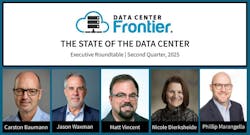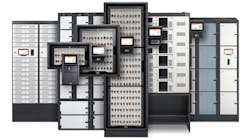Executive Roundtable: Strategies for Speed and Resiliency in Data Center Delivery
For the second installment of our Executive Roundtable for the Second Quarter of 2025, we asked our panel of experienced infrastructure leaders to weigh in on a defining tension in today’s infrastructure cycle.
The data center industry is moving at an unprecedented pace as AI demand continues to reshape design and delivery expectations. With GPU-intensive workloads driving the need for high-density environments, and with generative AI adoption accelerating across nearly every enterprise sector, infrastructure teams are being asked to do more, faster. This pressure is being felt not just in hyperscale campuses, but also in regional and edge deployments where speed to market now shapes competitive advantage.
This dynamic is reshaping how infrastructure teams approach execution. Standardization, modularity, and supply chain diversification have become strategic imperatives, not just cost optimizations. Electrical and mechanical designs are being pre-integrated to reduce risk. EPC and OEM partnerships are tightening to remove friction. And sustainability metrics from water usage to embodied carbon are being embedded earlier into the design-build process, as opposed to retrofitted at commissioning.
In today's roundtable, we ask: how are today’s industry leaders adapting to these constraints while maintaining resilience as a baseline requirement? Their answers reveal a blend of engineering discipline, operational foresight, and organizational agility that’s helping the sector deliver faster without compromising core infrastructure principles.
The seasoned data center industry leaders of our Executive Roundtable for the Second Quarter of 2025 include:
- Jason Waxman, CEO, CoolIT Systems
- Phillip Marangella, Chief Marketing and Product Officer, EdgeConneX
- Nicole Dierksheide, Global Category Director for Large Power, Rehlko
- Carsten Baumann, Director, Strategic Initiatives and Solution Architect, Schneider Electric
And now, on to our second Executive Roundtable question for Q2 of 2025.
Data Center Frontier: What strategies are helping you deliver infrastructure at speed without sacrificing resiliency? With timelines for data center delivery compressing across both hyperscale and edge environments, what proven approaches—whether in engineering, supply chain management, or partner collaboration—are enabling your organization to accelerate deployment while maintaining reliability, efficiency, and sustainability?
Jason Waxman, CoolIT Systems: When bringing a new product to market, we work closely with customers to define performance, reliability, and production requirements; then move fast.
For example, in our Liquid Lab™ Innovation centers in Calgary and Taipei, we rapidly design, prototype, test, and validate—as well as UL certify—new products all in-house. Our Liquid Labs allow us to compress development timelines without compromising quality or reliability.
Every CoolIT product is engineered using Design-for-X principles that consider performance, reliability, quality, manufacturability and serviceability from day one. So, when a product has completed testing, validation and certification, we are ready for manufacturing ramp. This includes making sure the supply chain can support a product’s production scale-up as well as provide components that meet or exceed our quality standards.
We’re also increased industrial automation in our assembly processes, including robotics and AI-driven optical inspection systems, to ensure high-quality, high-volume output.
Whether it's our own product or one custom-designed and produced for a customer, our rapid development capabilities combined with the ability to ramp manufacturing rapidly, ensure we can quickly bring new products to market at scale.
Phillip Marangella, EdgeConneX: Again, AI is dramatically transforming the way we build and operate our data centers. The speed and scale for both hyperscale and the edge have significantly increased in size by at least 3-5x, and the speed of delivery has been reduced in some cases to half the traditional timeframes.
Things like prefabrication, global purchase agreements for long-lead equipment, power reservations with utilities, and the acquisition of larger land banks result in a significantly greater capital commitment upfront.
We have to work more closely with the customer to understand their capacity forecasts, design requirements, and required delivery schedules, ensuring we are ready for service on time and on budget.
Nicole Dierksheide, Rehlko: We all know that the data center market is scaling at an unprecedented rate, and as a backup power provider, we're a key part of the total solution. One of our strengths has always been our ability to support both standard and custom generator configurations.
Our standard product lineup — like our popular 3-megawatt genset — is highly configurable using internal tools that allow customers to select from a range of options, such as alternator size or enclosure types. These tools streamline the process and provide fast access to pricing and bill of materials, which is essential for quick deployment.
However, data center projects often require more than off-the-shelf solutions. Heat rejection, airflow challenges, and unique site conditions, like high altitudes or extreme climates, can require modifications to standard equipment.
For instance, a site might need an oversized alternator for better airflow, or a configuration that accommodates stacked generators and additional piping. These types of customizations fall into what we call engineering specials, something we’ve long supported across our business.
To meet the speed and complexity of today’s data center demands, we've created dedicated teams focused solely on the data center segment. These teams include engineering, project management, and customer support resources who work directly with hyperscale and colocation customers throughout the lifecycle — from initial design through commissioning and beyond. This close collaboration helps ensure we meet all technical requirements while also staying on schedule.
We've also leaned heavily into digital transformation. We’re integrating digital tools and automation into our engineering and project workflows — not just in the products we deliver, but in how we operate internally. As the industry continues to grow rapidly, we know we can’t simply scale headcount at the same pace. So we're investing in AI and digital platforms to help us manage complexity, improve speed to market, and maintain the reliability and power quality our customers expect.
Carsten Baumann, Schneider Electric: Increasing manufacturing capacities is a clear strategy, but it carries long-term risk. To mitigate this, we are securing supply chain agreements with customers to ensure infrastructure capacity is available when needed, reducing risk for both parties.
An important factor for meeting compressed timelines is to design and build modularly. Prefabricated electrical, mechanical, and IT packages are accelerating the deployment of capacity, both for hyperscalers and at the edge. There are several advantages as various published use cases demonstrate.
NEXT: Standardization vs. Flexibility in Data Center Designs for the AI Era
Keep pace with the fast-moving world of data centers and cloud computing by connecting with Data Center Frontier on LinkedIn, following us on X/Twitter and Facebook, as well as on BlueSky, and signing up for our weekly newsletters using the form below.
About the Author
Matt Vincent
A B2B technology journalist and editor with more than two decades of experience, Matt Vincent is Editor in Chief of Data Center Frontier.








